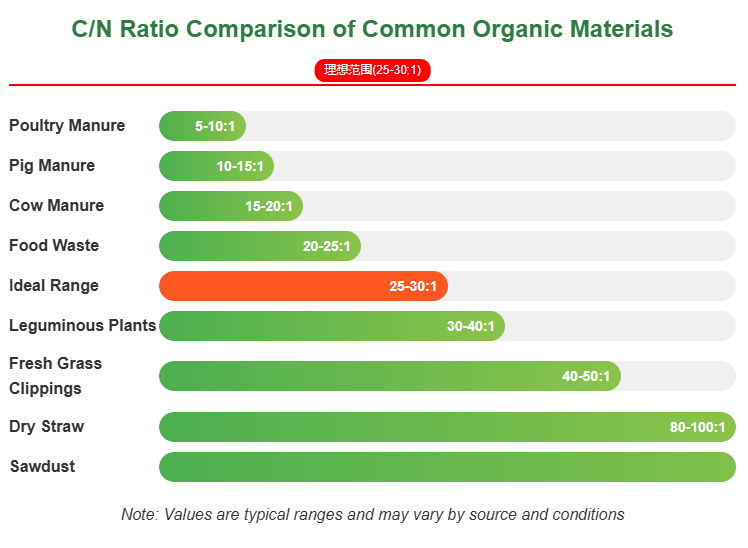Optimizing the production of organic fertilizers can be achieved by addressing the challenges of C/N ratio and fibrous materials.In fertilizer production lines, balancing C/N ratio and fiber content is crucial for efficient organic fertilizer manufacturing, ensuring proper decomposition and quality output.
Challenge 1: The C/N Ratio Dilemma
The carbon-to-nitrogen ratio (C/N) is a critical parameter affecting composting efficiency. The ideal range is 25-30:1. Deviation causes:
- Too high (>40:1): Microbes lack nitrogen, decomposition slows by 50%+
- Too low (<20:1): Significant nitrogen loss (up to 30%) with strong ammonia odor
Four Golden Rules for C/N Adjustment
| Imbalance | Amendment Materials | Mixing Ratio | Effect Timeline |
| High C/N | Chicken manure, soybean meal, urea | 20-40% | 3-7 days |
| Low C/N | Straw, sawdust, rice hulls | 30-60% | 7-14 days |
Pro Tip: Use portable C/N testers (±2 accuracy), test every 48 hours for dynamic adjustment. Increase C/N by 5-10% in summer, decrease by 5-10% in winter.
Challenge 2: High Fiber Content
When lignin/cellulose exceeds 35%:
- Temperature struggles to reach 55°C+ (pathogen kill rate insufficient)
- Composting extends to 60-90 days (normal 30-45 days)
- Final product contains 10-20% undigested fibers
Three-Step Advanced Fiber Treatment
Step 1: Mechanical Pretreatment
- Shred to 1-3cm particles (invest in 15-30kW straw crusher)
- Use fiber disruptors (40% efficiency gain)
Step 2: Biological Enhancement
- Inoculate with composite microbes (Trichoderma, etc.), 0.2-0.5% dosage
- Add 5-10% mature compost as “starter”
Step 3: Chemical Assistance
- Adjust pH to 7.5-8.5 (wood ash or lime)
- Add 0.5-1% urea solution for fast nitrogen
Innovation: Try novel cellulase enzymes (e.g. from Trichoderma reesei) – reduces cycle by 30% but increases cost 15-20%.
Benefits of Solving C/N Ratio & Fiber Challenges
Optimizing C/N ratio and fiber content in organic fertilizer production improves decomposition efficiency, enhances product quality, and reduces processing time. This leads to more stable, nutrient-rich fertilizers with better market value.
Connection to Production Process
Proper C/N balance (25-30:1) accelerates composting in the fermentation stage, while fiber adjustment ensures optimal porosity for aerobic digestion. These solutions directly impact critical process parameters like temperature control and maturation time in organic fertilizer production.
References:
[1] “Compost Science & Technology” (3rd Ed.), China Agriculture Press, 2022 [2] FAO Organic Fertilizer Production Guide, 2023 Revision [3] German Composting Association Technical Report, 2021


